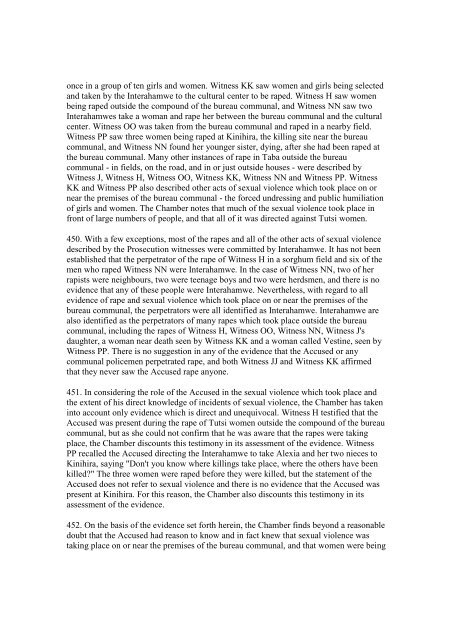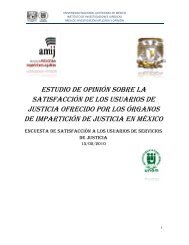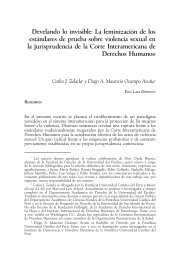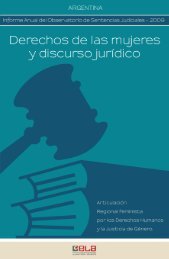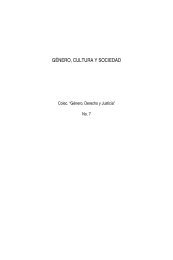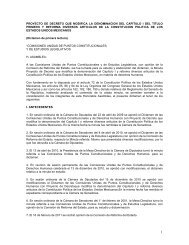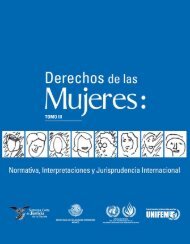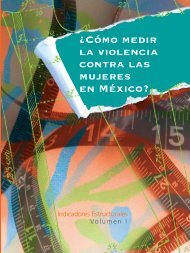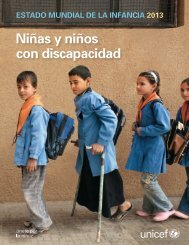once in a group of ten girls and women. Witness KK saw women and girls being selectedand taken by the Interahamwe to the cultural center to be raped. Witness H saw womenbeing raped outside the compound of the bureau communal, and Witness NN saw twoInterahamwes take a woman and rape her between the bureau communal and the culturalcenter. Witness OO was taken from the bureau communal and raped in a nearby field.Witness PP saw three women being raped at Kinihira, the killing site near the bureaucommunal, and Witness NN found her younger sister, dying, after she had been raped atthe bureau communal. Many other instances of rape in Taba outside the bureaucommunal - in fields, on the road, and in or just outside houses - were described byWitness J, Witness H, Witness OO, Witness KK, Witness NN and Witness PP. WitnessKK and Witness PP also described other acts of sexual violence which took place on ornear the premises of the bureau communal - the <strong>for</strong>ced undressing and public humiliationof girls and women. The Chamber notes that much of the sexual violence took place infront of large numbers of people, and that all of it was directed against Tutsi women.450. With a few exceptions, most of the rapes and all of the other acts of sexual violencedescribed by the Prosecution witnesses were committed by Interahamwe. It has not beenestablished that the perpetrator of the rape of Witness H in a sorghum field and six of themen who raped Witness NN were Interahamwe. In the case of Witness NN, two of herrapists were neighbours, two were teenage boys and two were herdsmen, and there is noevidence that any of these people were Interahamwe. Nevertheless, with regard to allevidence of rape and sexual violence which took place on or near the premises of thebureau communal, the perpetrators were all identified as Interahamwe. Interahamwe arealso identified as the perpetrators of many rapes which took place outside the bureaucommunal, including the rapes of Witness H, Witness OO, Witness NN, Witness J'sdaughter, a woman near death seen by Witness KK and a woman called Vestine, seen byWitness PP. There is no suggestion in any of the evidence that the Accused or anycommunal policemen perpetrated rape, and both Witness JJ and Witness KK affirmedthat they never saw the Accused rape anyone.451. In considering the role of the Accused in the sexual violence which took place andthe extent of his direct knowledge of incidents of sexual violence, the Chamber has takeninto account only evidence which is direct and unequivocal. Witness H testified that theAccused was present during the rape of Tutsi women outside the compound of the bureaucommunal, but as she could not confirm that he was aware that the rapes were takingplace, the Chamber discounts this testimony in its assessment of the evidence. WitnessPP recalled the Accused directing the Interahamwe to take Alexia and her two nieces toKinihira, saying "Don't you know where killings take place, where the others have beenkilled?" The three women were raped be<strong>for</strong>e they were killed, but the statement of theAccused does not refer to sexual violence and there is no evidence that the Accused waspresent at Kinihira. For this reason, the Chamber also discounts this testimony in itsassessment of the evidence.452. On the basis of the evidence set <strong>for</strong>th herein, the Chamber finds beyond a reasonabledoubt that the Accused had reason to know and in fact knew that sexual violence wastaking place on or near the premises of the bureau communal, and that women were being
taken away from the bureau communal and sexually violated. There is no evidence thatthe Accused took any measures to prevent acts of sexual violence or to punish theperpetrators of sexual violence. In fact there is evidence that the Accused ordered,instigated and otherwise aided and abetted sexual violence. The Accused watched twoInterahamwe drag a woman to be raped between the bureau communal and the culturalcenter. The two commune policemen in front of his office witnessed the rape but didnothing to prevent it. On the two occasions Witness JJ was brought to the cultural centerof the bureau communal to be raped, she and the group of girls and women with her weretaken past the Accused, on the way. On the first occasion he was looking at them, and onthe second occasion he was standing at the entrance to the cultural center. On this secondoccasion, he said, "Never ask me again what a Tutsi woman tastes like." Witness JJdescribed the Accused in making these statements as "talking as if someone wereencouraging a player." More generally she stated that the Accused was the one"supervising" the acts of rape. When Witness OO and two other girls were apprehendedby Interahamwe in flight from the bureau communal, the Interahamwe went to theAccused and told him that they were taking the girls away to sleep with them. TheAccused said "take them." The Accused told the Interahamwe to undress Chantal andmarch her around. He was laughing and happy to be watching and afterwards told theInterahamwe to take her away and said "you should first of all make sure that you sleepwith this girl." The Chamber considers this statement as evidence that the Accusedordered and instigated sexual violence, although insufficient evidence was presented toestablish beyond a reasonable doubt that Chantal was in fact raped.453. In making its factual findings, the Chamber has carefully considered the crossexaminationby the Defence of Prosecution witnesses and the evidence presented by theDefence. With regard to cross-examination, the Chamber notes that the Defence did notquestion the testimony of Witness J or Witness H on rape at all, although the Chamberitself questioned both witnesses on this testimony. Witness JJ, OO, KK, NN and PP werequestioned by the Defence with regard to their testimony of sexual violence, but thetestimony itself was never challenged. Details such as where the rapes took place, howmany rapists there were, how old they were, whether the Accused participated in therapes, who was raped and which rapists used condoms were all elicited by the Defence,but at no point did the Defence suggest to the witnesses that the rapes had not takenplace. The main line of questioning by the Defence with regard to the rapes and othersexual violence, other than to confirm the details of the testimony, related to whether theAccused had the authority to stop them. In cross-examination of the evidence presentedby the Prosecution, specific incidents of sexual violence were never challenged by theDefence.454. The Defence has raised discrepancies between the pre-trial written statements madeby witnesses to the Office of the Prosecutor and their testimony be<strong>for</strong>e this Chamber, tochallenge the credibility of these witnesses. The Chamber has considered thediscrepancies which have been alleged with regard to the witnesses who testified onsexual violence and finds them to be unfounded or immaterial. For example, the Defencechallenged Witness PP, quoting from her pre-trial statement that she stayed home duringthe genocide and recalling her testimony that she went out often as a contradiction. The
- Page 2 and 3:
1.2. The Indictment1.3. Jurisdictio
- Page 4 and 5:
eports2 which indicated that acts o
- Page 6 and 7:
3. Jean Paul AKAYESU, born in 1953
- Page 8 and 9:
16. Jean Paul AKAYESU, on or about
- Page 10 and 11:
Counts 7-8(Crimes Against Humanity)
- Page 12 and 13:
c) Deliberately inflicting on the g
- Page 14 and 15:
1.4. The Trial1.4.1. Procedural Bac
- Page 16 and 17:
y the opening statement for the Def
- Page 18 and 19:
y the Tribunal for crimes related t
- Page 20 and 21:
38. Regarding the Gishyeshye meetin
- Page 22 and 23:
witness was lying because he or she
- Page 24 and 25:
in the commune. His de facto author
- Page 26 and 27:
70. Apart from asking the prefect t
- Page 28 and 29:
84. According to the testimony of D
- Page 30:
Scores of political leaders were im
- Page 33 and 34:
his listeners to avoid the error of
- Page 35 and 36:
111. The killing of Tutsi which hen
- Page 37 and 38:
killed on the grounds that the foet
- Page 39 and 40:
128. In conclusion, it should be st
- Page 41 and 42:
Witness statements137. During the t
- Page 43 and 44:
protection of witnesses issued by t
- Page 45 and 46:
covered anyone who had anti-Tutsi t
- Page 47 and 48:
Tutsi and the Tutsi were accused of
- Page 49 and 50:
as "two armies", "two belligerents"
- Page 51 and 52:
"The primary criterion for [definin
- Page 53 and 54:
180. Many witnesses testified regar
- Page 55 and 56:
stated in that Decision, it did not
- Page 57 and 58:
deeds. For these reasons, the Chamb
- Page 59 and 60:
Concerning the allegation that at l
- Page 61 and 62:
turned over alive to Akayesu, and t
- Page 63 and 64:
younger brothers. He stated that he
- Page 65 and 66:
237. Karangwa testified under cross
- Page 67 and 68: three brothers lie on their stomach
- Page 69 and 70: known as Usuri (phonetic spelling)
- Page 71 and 72: Karangwa's explanation for the inco
- Page 73 and 74: Count 3, Crimes against Humanity (e
- Page 75 and 76: those killed were professors from R
- Page 77 and 78: 290. Witness DCC for the Defence, d
- Page 79 and 80: children, and old people. The Chamb
- Page 81 and 82: further that he had not heard of Ak
- Page 83 and 84: to fetch the one who remains', a pr
- Page 85 and 86: sector councillors called on the cr
- Page 87 and 88: According to witness A, the bourgme
- Page 89 and 90: present took it to mean that the Tu
- Page 91 and 92: 355. The Accused himself confirmed
- Page 93 and 94: 364. Paragraph 15 of the Indictment
- Page 95 and 96: The witness said a certain Françoi
- Page 97 and 98: has not been proved beyond reasonab
- Page 99 and 100: who had come to his house. He said
- Page 101 and 102: Interahamwe at the entrance, carryi
- Page 103 and 104: ack to the bureau communal and on t
- Page 105 and 106: Victim Y (Witness N), a [68] year o
- Page 107 and 108: which were at times committed by mo
- Page 109 and 110: communal into a forest in the area
- Page 111 and 112: clubbing a young teacher who had be
- Page 113 and 114: 434. Two days after arriving at the
- Page 115 and 116: he went into hiding during the mass
- Page 117: ureau communal, but he insisted tha
- Page 121 and 122: The Accused himself testified that
- Page 123 and 124: 464. In that case, when the matter
- Page 125 and 126: "A person who planned, instigated,
- Page 127 and 128: involve facilitating the commission
- Page 129 and 130: 493. In accordance with the said pr
- Page 131 and 132: Deliberately inflicting on the grou
- Page 133 and 134: y a psychological relationship betw
- Page 135 and 136: Chamber notes that, as stated above
- Page 137 and 138: • complicity by procuring means,
- Page 139 and 140: 547. Consequently, where a person i
- Page 141 and 142: underscoring their commitment to se
- Page 143 and 144: character134. In fact, the concept
- Page 145 and 146: 575. The definition of crimes again
- Page 147 and 148: grounds mentioned in Article 3 of t
- Page 149 and 150: accepted definition of this term in
- Page 151 and 152: adopted primarily to protect the vi
- Page 153 and 154: 610. Whilst the Chamber is very muc
- Page 155 and 156: description, namely, what constitut
- Page 157 and 158: forces to plan and carry out concer
- Page 159 and 160: 635. There is no clear provision on
- Page 161 and 162: 7.2. Count 5 - Crimes against human
- Page 163 and 164: 663. The definition of crimes again
- Page 165 and 166: 677. The Tribunal notes that eviden
- Page 167 and 168: 685. In the light of its factual fi
- Page 169 and 170:
692. The Tribunal finds, under Arti
- Page 171 and 172:
determine, as far as each proven fa
- Page 173 and 174:
the Tutsi in general. Akayesu who h
- Page 175 and 176:
722. As regards the allegations in
- Page 177 and 178:
732. The rape of Tutsi women was sy
- Page 179 and 180:
Chamber finds beyond a reasonable d
- Page 181 and 182:
Footnote 11. Decision: Order for Co
- Page 183 and 184:
Footnote 41. Article 104 of the Loi
- Page 185 and 186:
Footnote 68. Dictionnaire Rwandais-
- Page 187 and 188:
Footnote 103. "Principles of Intern
- Page 189 and 190:
Footnote 134. Secretary General's R
- Page 191:
Footnote 171. See General Legal Fin


